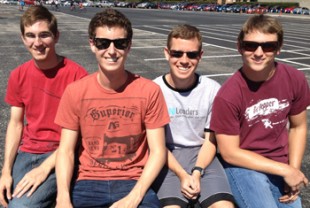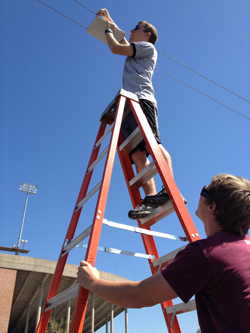Engineering students bring Beer Bike timing system into the 21st century
Tradition will meet technology for the first time at this year’s Beer Bike, Rice’s unique competition among residential colleges, graduate students and alumni in which teams of cyclists race and teams of chuggers drink water or beer, depending on their age and preference, in alternating rounds.

Team Timekeepers -- from left, Paul Melvin, Blake Miller, Ryan Koehn and Shaun Haby -- have built a timing system for Beer Bike that uses helmet-mounted RFID tags to time races with .3-second accuracy.
The March 23 event west of Rice Stadium will for the first time have an electronic timekeeping system, courtesy of a hardworking team of seniors who took on the challenge as their engineering capstone project.
Most capstones are due to be completed by next month’s Engineering Design Showcase and Poster Session, but Paul Melvin, Blake Miller, Ryan Koehn and Shaun Haby – collectively known as the Timekeepers — chose to attack a problem with a tighter deadline.
“But we get to see the results,” Melvin said while his teammates set up the rig for testing at the West Lot track last week. “It’s awesome because I get to tell other Rice students what I’m doing for senior design, and every single one says, ‘Wow, that’s really cool.’”
For all of Beer Bike’s 55-year history, volunteer judges holding stopwatches, clipboards, pencils and flags have determined the winners. “They have a lot of things they’re trying to manage and there’s not a whole lot of training for judges, so ones who haven’t already done it for several years may or may not really know what they’re doing,” Melvin said.

Ryan Koehn attaches an RFID antenna to cables that will be suspended over the finish line at Beer Bike. The antennas pick up signals from the bikers' helmet-mounted tags when they come within range.
The students’ system is based on radio frequency identification (RFID) technology commonly used in race timing. “We had a lot of different ideas,” he said. “We considered GPS, a video camera at the finish line or some sort of directional sensor. We considered something as simple as having more judges with stopwatches, which obviously isn’t very much of a design solution.
“We thought from the get-go that it would be RFID, because it’s the same technology used in most marathons. It’s established for timing races, it’s highly accurate and it’s also within our scope of abilities – and our budget,” Melvin said.
The tags are simple circuits printed on stickers that will go on riders’ helmets. The passive tags will be encoded and matched with riders in the timer’s computer; the tags will be read by 10 square RFID antennas suspended on steel cables over the finish line. The team calculated that times would be accurate to within .3 seconds.
Using off-the-shelf electronics in no way simplified the challenges the team faced. They still had to design the physical system and software. The suspension system for the antennas “was a significant portion,” Melvin said. “That was completely done by Shaun, our mechanical engineer, who had to calculate all the forces, all the tensions on the wire rope, figure out how wide and how thick each beam needed to be, what we could weld, what we could bolt, how it could be assembled. That was a major undertaking.”
The students constructed the modular steel structure from raw 20-foot beams, cutting and welding at Ryon Lab and doing finish work at the Oshman Engineering Design Kitchen. Four water-filled 50-gallon drums anchor each side of the structure, which will be padded for safety by race time. Miller, he said, led the graphic user interface software design.
This year the RFID system will work in tandem with human judges, said Julie Neisler, assistant director for programs of the student center and liaison to Team Timekeepers. “This year we’ll do both and compare to see how close it is, really to see if the timing system works – and if so, how much human error there is, which I think will be interesting,” she said. “If it goes well, we’ll still have judges next year but they won’t have to keep track of times.”
She noted the team has high-profile backers who covered the cost of the system, among them Harris County Judge Ed Emmett ’71, the Rice Engineering Alumni association and the John P. Schroeter (’74) Memorial Graduate Alumni Gift Fund. Gary Woods, a professor in the practice of computer technology and electrical and computer engineering, is the team’s faculty adviser.
Emmett takes some credit for the idea. “Last year, I was one of the starters for the Beer Bike race and watched the race from the tower,” he said. “At that time I asked if there wasn’t a way to use RFID chips to keep track of the riders. Even though I never rode or drank for my college, I value the tradition of the race and wanted to help move it to the next level.”
If things go well this year, the RFID system may take sole timing responsibility in 2014, Neisler said.
“Our project is to design something that can be used for years to come,” Melvin said. “We expect this to be good to go for, hopefully, 20 to 30-plus years.”
There is room for enhancement, he noted. Proposals to build a Web interface to provide real-time updates online and an onsite leaderboard are still up for grabs by future capstone teams.
“Then you can see on the Web, in real time, ‘Hey, McMurtry has got its ninth rider on lap two right now, and they’re in the lead, but Jones is 10 seconds behind.’ That would be awesome,” he said.



This is a good idea. This kids are really talented.